Home | Front Page | Index | Blog | New | Contact | Site Map
Lake Peten Itza
Tikal
Coban
Guatemala City
Lake Atitlan
Markets
Antigua
Rio Dulce
Esquipulas
Mundo Maya
Foto Show

Central America
Route Maps
Belize
Honduras
Nicaragua
Costa Rica
Panama
Mexico 2003-04:
USA 2003
USA 2002
Britain 2002
More Market Pics

Chichicastenango's Cemetery |
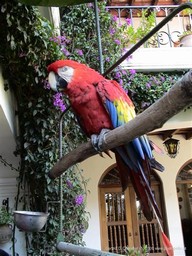
Pet Scarlet Macaw |

All is not Fabric
Flower Market |
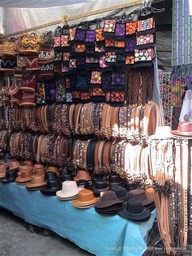
Come and Buy |
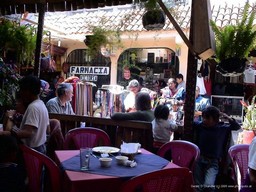
There's No Escape |
We made two excursions away from Lake Atitlan to visit indigenous markets at Solola and Chichicastenango.
Solola
Solola sits on the rim of the ancient crater, almost visible from Panajachel, but five miles away. The village sits up in a high valley about 100 meters above the lake. All of the streets that run toward the lake end with a sudden drop off and breathtaking panoramic views of the lake. It has a Friday and Sunday market and we went early on a Friday. The market was very authentic and reminded us of Cocly, Vietnam.
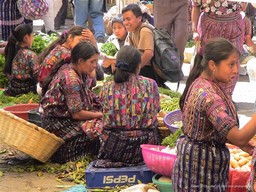
Tribal Women in Solola |
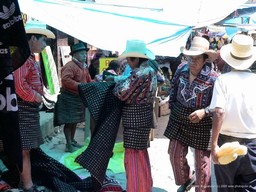
Tribal Men Buying Their Blankets in Solola |
Most of the mature women were in their colorful garb and the older men wore a blanket-like skirt around their waist over their cotton pants. On inquiry we learned that such a skirt-blanket costs about Q400 ($50) and would last 3-4 years. The market itself was spread over the central square and along streets for two blocks in every direction. Half or so was devoted to fruit and vegetables but everything from light bulbs to wallets to oven cleaner was available. Locals far, far outnumbered tourists.
Chichcastenango
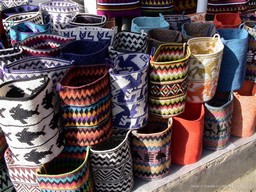
Guatemalan Handicrafts at Chichicastenango Market |
Two days later we went to the Sunday Chichicastenango market, getting up at 6 am to reach it early in the day. While only 40 km (25 miles) and an hour away from Panajachel by road it is a world away in experience. A hundred years ago, or maybe just 15, when there were no roads and no buses few would have made the trip lightly. It requires climbing about 1000 meters (3000 ft) over the mountains and then descending and doing the same on the return trip. (The British group we had met near San Juan had done it as walking tourists in five days.) Without electricity and without television and phones the people of Chichicastenango, Solola, and Panajachel would have been very isolated from one another. That easily explains why they wore and still to some extent wear distinctive clothes that told one another who was a local and who was a stranger.
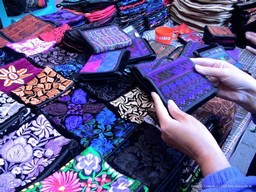
A Riot of Color |
The term a "riot" of color must have been invented here. Overall the market is five or six times as large as the one at Solola. The market is impressive too because of the sheer number of stall holders trying to sell their wares. All is directed toward the tourist and tourist dollar. Tourist buyers far, far outnumber local sellers and buyers. Local hotels fill up the night before and tourist buses arrive very early in the morning. By 11 a.m. it is hard to pass through any of the central streets where there are stalls.
We inquired of two stall holders and heard the same story: it costs Q1 (about 12.5 cents) a day to have a stall. There are about 1000 stalls and there is no place for any more. Stall holders always go to the same spot, putting their stall up late Saturday or very early Sunday. These stalls, each about 10 feet by six feet, might be called canvas lean-tos: there are upright poles around three sides held together by ropes and a few roof poles. Around the side, back, and top is plastic sheeting, canvas, or a tarp. The merchants hang their clothes on the back or from the ceiling or put shallow shelves at the back where they place carved goods and leather goods. Before the opening of each market there are ceremonies that are a mixture of Catholic and indigenous rituals; we missed these because we didn't overnight in Chichi.
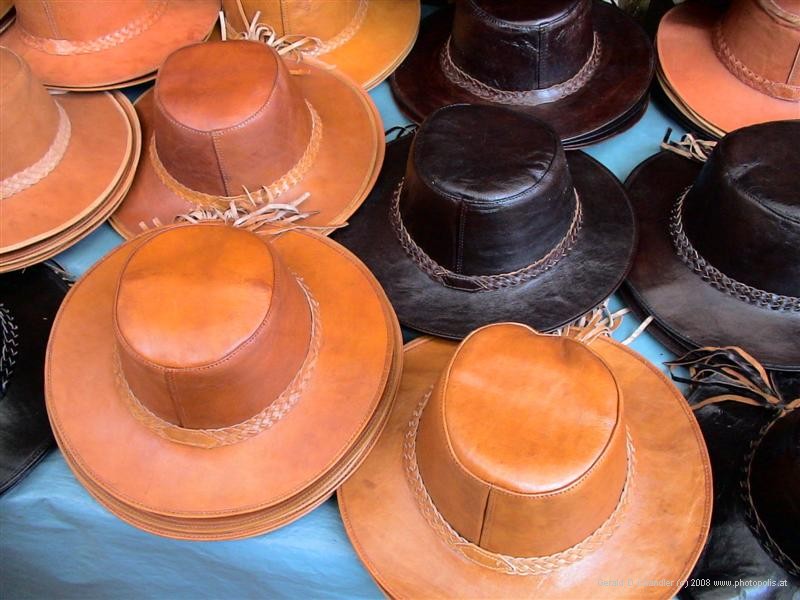
Not Everything is for the Ladies |
When we arrived we could still walk around easily. After an hour of this (we tried very hard not to buy anything) we went to the central church and sat in on mass for 20 minutes. We, unlike the vast majority, didn't take communion. Instead we walked out and went to the west side of town and toured the cemetery. It is rather pretty with many above ground tombs, painted in bright pastel colors. While there we saw a burial taking place. Unlike in the USA or UK, where all is sanitized, the family group stood around while the grave itself was being dug. While in town at most stalls people were wearing traditional colorful dress, most in the funeral party were in more western clothing.
Back in town we toured the tiny museum, housed in a one-story restored Spanish colonial building, which was interesting, but had much the same stuff we'd seen in the larger Guatemala City museums. Nonetheless, they had an impressive collection of ancient goods from local Mayas. We then made another short tour of the stalls. This time we could hardly move about. Jan bought some gift items and wished we had a home to justify buying things for us.
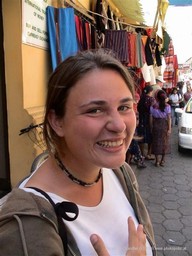
German Volunteer Nora |
While doing this we met Nora, a young German of about 22, who was so lively and vivacious we liked her immediately. She had been doing volunteer work in forestry in Costa Rica and now was doing a shorter version of our trip (and even shorter than that of Dirk Harlacher) on her way back to Germany. We enjoyed her tales so much, we invited her to lunch where we got to learn more about her ambitions. One interesting tidbit was that she, like Dirk, had spent a year in high school in the USA. We asked her to estimate how many Germans did this; she guessed that in her school and her year (about six years ago) one-third of her schoolmates spent a year in the USA. We marvel at the extent of this cross-cultural exchange. Unfortunately, she said that anti-USA feeling due to the Anti-Saddam War has made many young Germans seek someplace else for their year abroad.
At a table near us there was a group of Israeli's on a 9 day tour. To paraphrase an old radio show, Guatemala is filled with millions of people and there are millions of stories. In this case the leader of the group teaches at Tel Aviv University; he finances his travels by leading such groups. He said that he wished he could do it the way we are. We are fortunate indeed.